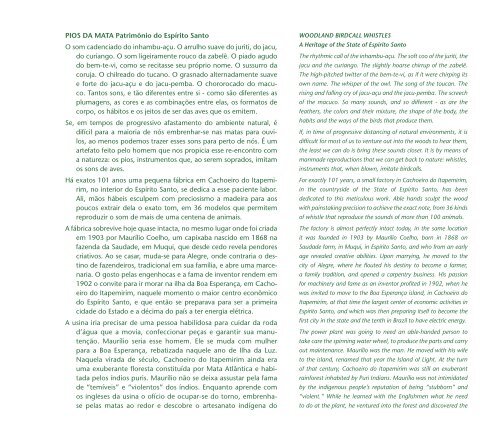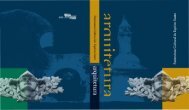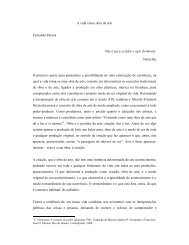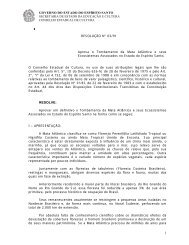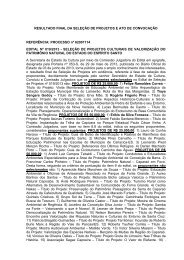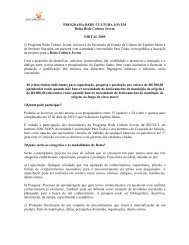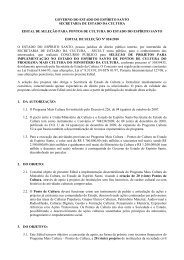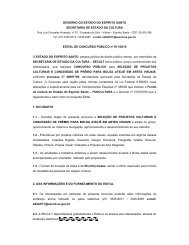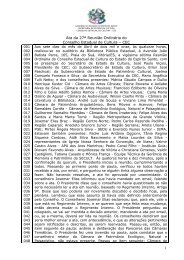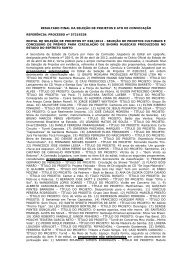Create successful ePaper yourself
Turn your PDF publications into a flip-book with our unique Google optimized e-Paper software.
PIOS DA MATA Patrimônio do Espírito Santo<br />
O som cadenciado do inhambu-açu. O arrulho suave do juriti, do jacu,<br />
do curiango. O som ligeiramente rouco da zabelê. O piado agudo<br />
do bem-te-vi, como se recitasse seu próprio nome. O sussurro da<br />
coruja. O chilreado do tucano. O grasnado alternadamente suave<br />
e forte do jacu-açu e do jacu-pemba. O chororocado do macuco.<br />
Tantos sons, e tão diferentes entre si - como são diferentes as<br />
plumagens, as cores e as combinações entre elas, os formatos de<br />
corpo, os hábitos e os jeitos de ser das aves que os emitem.<br />
Se, em tempos de progressivo afastamento do ambiente natural, é<br />
difícil <strong>para</strong> a maioria de nós embrenhar-se nas matas <strong>para</strong> ouvilos,<br />
ao menos podemos trazer esses sons <strong>para</strong> perto de nós. É um<br />
artefato feito pelo homem que nos propicia esse re-encontro com<br />
a natureza: os pios, instrumentos que, ao serem soprados, imitam<br />
os sons de aves.<br />
Há exatos 101 anos uma pequena fábrica em Cachoeiro do Itapemirim,<br />
no interior do Espírito Santo, se dedica a esse paciente labor.<br />
Ali, mãos hábeis esculpem com preciosismo a madeira <strong>para</strong> aos<br />
poucos extrair dela o exato tom, em 36 modelos que permitem<br />
reproduzir o som de mais de uma centena de animais.<br />
A fábrica sobrevive hoje quase intacta, no mesmo lugar onde foi criada<br />
em 1903 por Maurílio Coelho, um capixaba nascido em 1868 na<br />
fazenda da Saudade, em Muqui, que desde cedo revela pendores<br />
criativos. Ao se casar, muda-se <strong>para</strong> Alegre, onde contraria o destino<br />
de fazendeiros, tradicional em sua família, e abre uma marcenaria.<br />
O gosto pelas engenhocas e a fama de inventor rendem em<br />
1902 o convite <strong>para</strong> ir morar na ilha da Boa Esperança, em Cachoeiro<br />
do Itapemirim, naquele momento o maior centro econômico<br />
do Espírito Santo, e que então se pre<strong>para</strong>va <strong>para</strong> ser a primeira<br />
cidade do Estado e a décima do país a ter energia elétrica.<br />
A usina iria precisar de uma pessoa habilidosa <strong>para</strong> cuidar da roda<br />
d’água que a movia, confeccionar peças e garantir sua manutenção.<br />
Maurílio seria esse homem. Ele se muda com mulher<br />
<strong>para</strong> a Boa Esperança, rebatizada naquele ano de Ilha da Luz.<br />
Naquela virada de século, Cachoeiro do Itapemirim ainda era<br />
uma exuberante floresta constituída por Mata Atlântica e habitada<br />
pelos índios puris. Maurílio não se deixa assustar pela fama<br />
de “temíveis” e “violentos” dos índios. Enquanto aprende com<br />
os ingleses da usina o ofício de ocupar-se do torno, embrenhase<br />
pelas matas ao redor e descobre o artesanato indígena do<br />
WOODLAND BIRDCALL WHISTLES<br />
A Heritage of the State of Espirito Santo<br />
The rhythmic call of the inhambu-açu. The soft coo of the juriti, the<br />
jacu and the curiango. The slightly hoarse chirrup of the zabelê.<br />
The high-pitched twitter of the bem-te-vi, as if it were chirping its<br />
own name. The whisper of the owl. The song of the toucan. The<br />
rising and falling cry of jacu-açu and the jacu-pemba. The screech<br />
of the macuco. So many sounds, and so different - as are the<br />
feathers, the colors and their mixture, the shape of the body, the<br />
habits and the ways of the birds that produce them.<br />
If, in time of progressive distancing of natural environments, it is<br />
difficult for most of us to venture out into the woods to hear them,<br />
the least we can do is bring these sounds closer. It is by means of<br />
manmade reproductions that we can get back to nature: whistles,<br />
instruments that, when blown, imitate birdcalls.<br />
For exactly 101 years, a small factory in Cachoeiro do Itapemirim,<br />
in the countryside of the State of Espírito Santo, has been<br />
dedicated to this meticulous work. Able hands sculpt the wood<br />
with painstaking precision to achieve the exact note, from 36 kinds<br />
of whistle that reproduce the sounds of more than 100 animals.<br />
The factory is almost perfectly intact today, in the same location<br />
it was founded in 1903 by Maurílio Coelho, born in 1868 on<br />
Saudade farm, in Muqui, in Espírito Santo, and who from an early<br />
age revealed creative abilities. Upon marrying, he moved to the<br />
city of Alegre, where he flouted his destiny to become a farmer,<br />
a family tradition, and opened a carpentry business. His passion<br />
for machinery and fame as an inventor profited in 1902, when he<br />
was invited to move to the Boa Esperança island, in Cachoeiro do<br />
Itapemirim, at that time the largest center of economic activities in<br />
Espírito Santo, and which was then preparing itself to become the<br />
first city in the state and the tenth in Brazil to have electric energy.<br />
The power plant was going to need an able-handed person to<br />
take care the spinning water wheel, to produce the parts and carry<br />
out maintenance. Maurílio was the man. He moved with his wife<br />
to the island, renamed that year the Island of Light. At the turn<br />
of that century, Cachoeiro do Itapemirim was still an exuberant<br />
rainforest inhabited by Puri Indians. Maurílio was not intimidated<br />
by the indigenous people’s reputation of being “stubborn” and<br />
“violent.” While he learned with the Englishmen what he need<br />
to do at the plant, he ventured into the forest and discovered the


